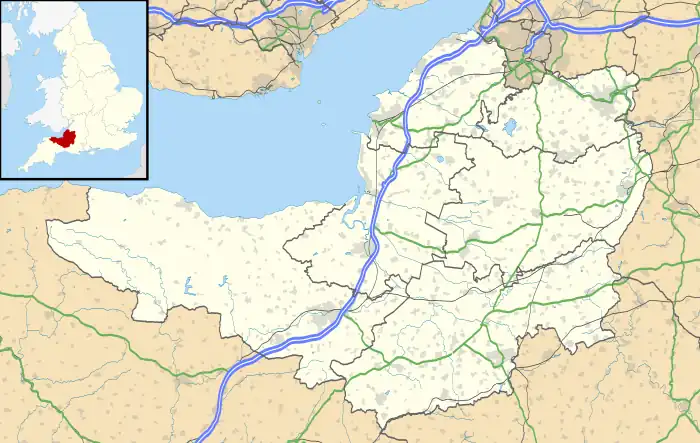| Fenny Castle | |
|---|---|
 | |
| Location | Wookey, Somerset, England |
| Coordinates | 51°11′22″N 2°42′19″W / 51.18944°N 2.70528°W |
| Built | c. 1140 |
| Official name | Fenny Castle |
| Reference no. | 197243[1] |
 Location of Fenny Castle in Somerset | |
Fenny Castle is the remains of a motte and bailey castle in the parish of Wookey, Somerset, England. It is a Scheduled Ancient Monument,[1] but not accessible to the public.[2]
It is sited on a natural hillock of Lias approximately 20 metres (66 ft) above the surrounding flat land on the edge of the Somerset Levels.[3] Such sites were typically chosen for castles in low-lying areas.[4]
The original builder of the castle is unknown, but it may be associated with the Anarchy, 1135–1153, a period of English history during the reign of King Stephen which was marked by a succession crisis between the supporters of Stephen and those of his cousin, the Empress Matilda. In 1327 the owner was William atte Castle.[1] By 1480 it was described as a ruin by William Worcestre who saw the plan of "all the houses and offices there".[5] During the 19th century the quarrymen found twenty skeletons which were reported as dating from an unspecified period before the construction of the castle.[1]
The castle gave its name to a hamlet of the parish of Wookey named 'Castle', one mile south-west of the main village. A stone cross in the hamlet, marking its importance, was still to be seen in 1839.[6]
Little remains of the stonework, and there is evidence of extensive quarrying. The mound is now covered in grass and scrub with a few trees.[3] However, the site was described in The Archaeology of Somerset (1982) as still having "interesting and prominent earthworks".[7]
See also
References
- 1 2 3 4 "Fenny Castle". Pastscape — National Monument Record. English Heritage. Archived from the original on 25 March 2012. Retrieved 13 May 2011.
- ↑ "Somerset Historic Environment Record". somersetheritage.org. Retrieved 6 December 2021.
- 1 2 "Fenny Castle". Somerset Historic Environment Record. South West Heritage Trust. Retrieved 13 May 2011.
- ↑ O. H. Creighton, Castles and landscapes: power, community and fortification in Medieval England (2002), p. 38: "In low-lying marshy areas a castle was very often raised on a natural eminence, typically a glacial knoll, as at Fenny Castle, Wells (Somerset)..."
- ↑ Dunning, Robert (1995). Somerset Castles. Tiverton: Somerset Books. p. 58. ISBN 0-86183-278-7.
- ↑ William Phelps, The History and Antiquities of Somersetshire, part 1, 'The parochial history continued, viz. The city and cathedral of Wells; the hundreds of Wells Forum and Whitstone' (1839), p. 172
- ↑ Michael Aston, Ian Burrow, The Archaeology of Somerset: a review to 1500 AD (1982), pp. 9-12